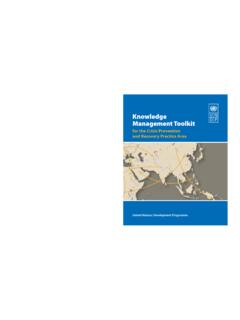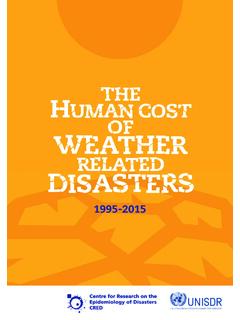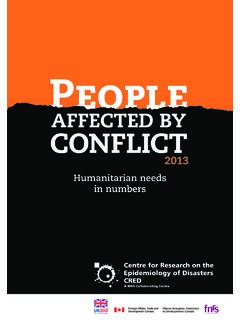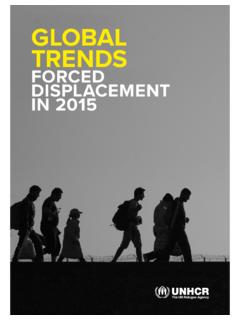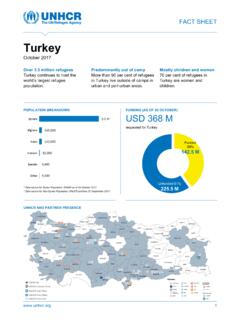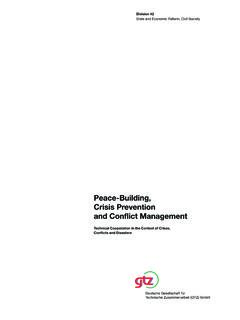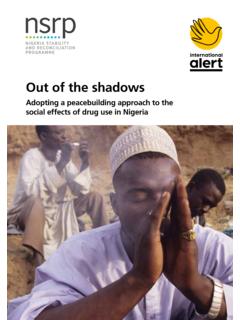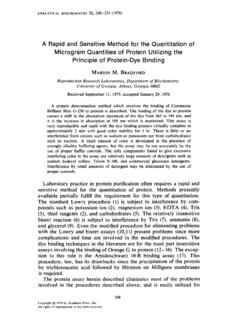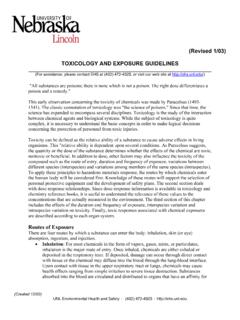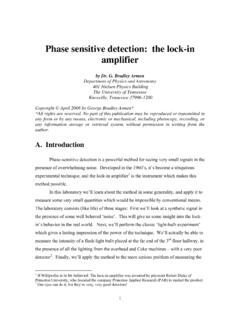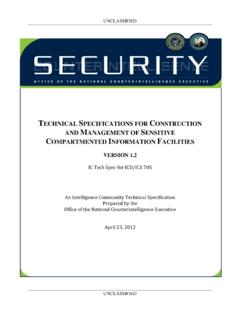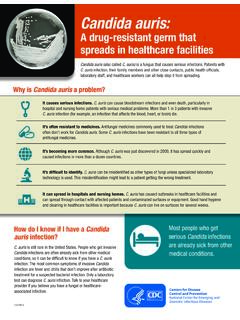Transcription of A Principled Approach to Conflict Sensitive Do No Harm ...
1 1 A Principled Approach to Conflict Sensitive Do No harm Programming in the context of Federal Iraq and the Kurdistan Region Emergency Livelihoods and Social Cohesion & Cluster Contents: Overview of Conflict Sensitive Do No harm Programming in Iraq Pages 1 - 7 Annex A - Checklist for Conflict Sensitive Programs. Pages 8 9 Annex B - Resources for Conflict Sensitive Programming. Page 10 Overview of Conflict Sensitive Do No harm Programming in Iraq. Background As the crisis in Iraq enters its third year, social tensions continue to rise in areas where IDPs are settled. In particular, recent attention has been directed to the finding that humanitarian agencies and government actors themselves may be contributing, inadvertently, to tensions between groups of displaced populations and between IDPs and host communities. This note seeks to enable humanitarian actors working under pressure and time constraints to enhance Conflict sensitivity in their projects.
2 This guidance note is supported by analysis of the development of social tensions undertaken in June 2015 by EL & SC cluster and the establishment of a comprehensive information system existed to monitor social tensions and the connection with the dynamics of the socio-political and historical contexts. One of the most important predictors of social tensions was found to be directly linked to the need for social services. In particular, host communities that have a high proportion of residents who rely upon the government for basic needs are shown to be around 30 times more likely to have negative perceptions of and hostile relationships with IDPs. Inequitable access to social services such as food assistance, education, health, and electricity were found to be a significant trigger in 72% of social tension incidents which, in some cases, evolved to violent Conflict . Evidence from disputed areas such as Khanaqin and Kirkuk, but also in camps and host communities in uncontested areas in the Kurdistan Region of Iraq, demonstrate that inequitable distribution of supplies to IDPs and host communities does in fact increase community tensions.
3 This indicates that the humanitarian community and its government partners are at risk of unknowingly increasing tensions or Doing harm in communities they seek to serve. To identify and support those most at risk, the Emergency Livelihoods & Social Cohesion Cluster have constructed a Social Tensions Tracking and Mapping system (STTM) that identify geographic areas containing communities vulnerable to social tensions and thus predict where tensions are most likely arise. This system uses an index of the predictors of tensions tested by the social cohesion analysis and used to provide and evidence base in the Humanitarian Needs Overview (HNO) of the 2016 Humanitarian Response Plan (HRP). Objectives This document has been prepared in response to a request from the Inter-Cluster Coordination Group (ICCG) for guidance from the ELSC cluster to produce a set of operationalized guidelines for Conflict Sensitive programming. The objective is to highlight, for humanitarian organizations and government partners, the importance of planning and implementing emergency programs through a lens of Conflict sensitivity.
4 It provides an overview of the basic steps of Conflict Sensitive programming and concludes with a list of resources for further information. The ultimate goal of this guide is to enable humanitarian actors to effectively contribute to opportunities for social cohesion and reduce incidents of tension during all phases of 2 humanitarian aid programming. It will be particularly relevant in areas where social tensions are already evident, but also any area in Iraq where there are IDPs or refugees now live. Therefore, this guide will: Define necessary terms and principles for Conflict Sensitive programming. Provide a basic overview of do no harm principles and guidelines. Provide a brief set of steps for incorporating Conflict Sensitive principles in all steps of program design, implementation, monitoring and evaluation and integration of these principle in to institutional practices, starting on page 5 and a check list in Annex A. Refer readers to additional resources for detailed steps to Conflict analysis, assessment of dividers and connectors via the Do No harm model.
5 Provide a Checklist for Conflict Sensitive Programs in Annex A page 9-10. Basic Definitions Conflict - The result of parties disagreeing and acting on the basis of perceived incompatibilities. Conflict (violent) - Resorting to psychological or physical force to resolve a disagreement. Conflict Analysis - A structured process of assessment and analysis to better understand a Conflict (its background/history, the groups involved, each group s perspective, identifying causes of Conflict etc.) This is a dynamic analysis and needs to be updated as conflicts evolve. Conflict sensitivity - refers to the ability of an organization to: o Understand the context in which it is operating, particularly intergroup relations; o Understand the interactions between its interventions and the context/group relations; and o Act upon the understanding of these interactions, in order to avoid negative impacts and maximize positive impacts. Conflict - Sensitive programming - involves close scrutiny of the operational context through regularly updating the Conflict analysis, in order to avoid negative impacts and maximize positive impacts on the context.
6 Context - The operating environment, which ranges from the micro to the macro level ( community, district / province, region(s), country, neighboring countries). do no harm - The principle of do no harm is taken from medical ethics. It requires humanitarian organisations to strive to minimize the harm they may inadvertently cause through providing aid, as well harm that may be caused by not providing aid (such as adding to tensions with host communities). Do No harm (DNH) - Originated by CDA Collaborative ( ) the practice of DNH is based on 6 important assumptions 1. Whenever an intervention of any sort enters a context it becomes part of the context. 2. All contexts are characterized by Dividers and Connectors. 3. All interventions interact with both, either making them worse or making them better. 4. Actions and Behaviors have Consequences, which create impacts. 5. The details of interventions matter. 6. There are always Options. Peacebuilding - Measures designed to consolidate peaceful relations and strengthen viable political, socio-economic and cultural institutions capable of mediating Conflict , and to strengthen other mechanisms that will either create or support the necessary conditions for sustained peace.
7 (Often confused with Conflict Sensitive programming recommended reading: ) Social Cohesion in the current context of Iraq, social cohesion is defined as a general condition of stable co-existence within communities, when IDPs, refugees, and host community members accept 3 socio-ethnic differences, have equitable access to livelihoods and other community resources, and feel safe and secure in their homes. The Basics of Conflict Sensitive Programming and the Do No harm Approach (See Checklist for Conflict Sensitive Programs in Annex A page 9-10, for the Iraq/Kurdistan context) As highlighted in the previous section, Conflict sensitivity - refers to the ability of an organization to: 1. Understand the context in which it is operating, particularly intergroup relations; 2. Understand the interactions between its interventions and the context/group relations; and 3. Act upon the understanding of these interactions, in order to avoid negative impacts and maximize positive impacts.
8 An analysis of tensions in the region, similar to section one, is a first step to allow us to understand some of the effects of Conflict , displacement and humanitarian aid on communities. A full endeavor toward Conflict Sensitive programming requires an even more thorough Conflict analysis localized to humanitarian settings. A short, operationally-oriented guide to Conflict analysis is presented here and resources are recommended in the reference section. In brief and at a minimum, a Conflict analysis should include an understanding of: Components Examples Groups involved Arab (Sunni/Shia), Kurd (diverse), Yezidi, Christian, Turkman, Shabak, Kakai, Fayli, tribal groups, Baath, international governments, humanitarian organizations, etc. Background/ history history of Conflict and military alliances Arabization or Kurdification de-Ba athification foreign occupations religious persecution militia and terrorist acts etc. Underlying causes of Conflict Political competition and alliances Sunni/Shia, PDK/PUK/YPK, Federal Iraq/KR-I, Kurd/Arab, East/West etc.
9 Culture and identity religion, ethnic Security needs Competition over resources government, humanitarian aid, political parties, tribal alliances, etc. Perspectives fear, long standing resentments, power/influence, political and resource competition, etc. In essence, the Do No harm model of Conflict Sensitive programming (see resource list attached), states that the Actions and Behaviors of humanitarian actors have Consequences on the individuals and group dynamics and context in which humanitarian assistance is being provided. Simply speaking, regardless of our most neutral or even positive intentions, the resources and information we bring into the field may have negative influences and can cause harm . Actions & Behaviors = Consequences Actions: In general, there are five ways humanitarian support can have negative effects on social-tension and cause Conflict in communities. The effects are likely to be greater if packages of aid are being distributed but the same principles also apply to less concrete interventions, including provision of psychosocial care, awareness raising and advocacy campaigns.
10 None of these has to do with precisely what we bring into a context, but rather how we go about storing, maintaining and sharing those resources. 4 Actions Definitions Conflict Insensitive Examples Conflict Sensitive Examples Distribution Effects: Distributing resources, information, services, water etc. along the lines of an existing tension or division. providing support only to IDPs or refugees and overlooking host community. Recognizing that host community vulnerability has increased with IDP/refugee presence and supporting host community as well. Legitimization Effects: Giving legitimacy to a group or leader by working with them using a beneficiary list from a tribal or political leader or security forces rather than having transparent and neutral selection criteria. Cross checking distribution lists from different leaders to assure equal representation. Market Effects: Changing local markets with an influx of outside resources providing resources from outside the region can alter market prices, value change and labor patterns.
